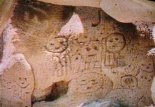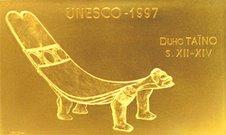Thanksgiving is the only holiday celebrated in the United States which was inspired by and is a descendant of a celebration practiced for untold centuries by America's first peoples. Of course, this is a holiday with a history and that history includes Native peoples. But Americans know very little about indigenous peoples, even the Natives of the places where they live. And they don't know very much about history, even their own. Therefore, surprisingly few people know where the Thanksgiving tradition comes from or how its modern manifestation became an American tradition and a legal holiday.
The history of Thanksgiving as a legal holiday starts with a sad story. In 1863, following the battle of Gettysburg during the Civil war, President Lincoln visited the battlefield. It was one of the saddest moments in the history of the Republic. Robert E. Lee and the army of the Confederacy had been turned back, but at an almost unbearable cost. Over three days of fighting, some 50,000 Americans were killed. It was the worst loss of American life on the battlefield in history before or since. It is said that its impact was felt in almost every town and village North and South. Lincoln expressed the sentiment that at that moment the country needed something positive to celebrate and asked aides to scour American history for a tradition that could serve the purpose. They did, and they found a day of celebration that had been associated with the Connecticut Puritans early during the 17th century but which had been discontinued by 1863. He thought it was the perfect memorial and ordered a new national holiday: Thanksgiving.
Most Americans' shared version of the origin of Thanksgiving skips over Lincoln and the Gettysburg battlefield and goes directly to the original Puritans, but the story is usually abbreviated. The Puritans survived the first year to enjoy a harvest and decided to do a ceremony they had done at home, the Home Harvest. They then invited the Indians for a feast and the two groups enjoyed turkey, cranberries, and pumpkins. One sees visual representations of this showing the Puritans serving dinner to the Indians, but that's not exactly how it happened. The English at Plymouth had been lucky, very lucky, and had a lot to be thankful for.
The story begins in 1605 when a Wampanoag Indian accompanied a friendly English explorer, John Weymouth, to England. The Indian is known to us today as Squanto and while in England he learned English. He returned to New England but was later captured by an English slaver (the English were big-time slavers for centuries) and sold to the Spanish in the Caribbean. A priest befriended him and helped him get to Spain and later to England where he found Weymouth who paid his way home. While in England he met a Wabanake individual who had traveled with an English explorer, Samoset. Both returned to Patuxet, present-day Plymouth, in 1620 but they found the village deserted because of epidemic disease which was probably introduced by slavers. They went to live in a nearby Wampanoag village.
The following year they were hunting when they came upon the English who had settled at the very spot that Squanto's village had stood. The English were startled to meet Indians who spoke their language. The English were in bad shape, almost half had died over the winter, and they had too few survival skills. Squanto stayed with them for the next few months and taught them how to cultivate corn and beans and to build Indian-style shelters. He brought venison and taught them to dig clams and showed them medicines. By fall, thanks mostly to Squanto, the English were doing much better and they had enough food to last the winter.
The agricultural Indians of the Northeast woodlands, including the Algonkians of which the Wampanoag were members, celebrated the fruits of the harvest and the arrival of the hunting season in November with a feast which included three days of dancing, singing, and speeches of thanksgiving. Indeed, most of the North American Indian cultures had a whole calendar year of ceremonials of thanksgiving. There were six such major ceremonials of thanksgiving among the New England peoples. They told the English about their custom and asked about a joint celebration. The English could remember a similar ceremony, Home Harvest, practiced in England for centuries, and the two had found something they had in common. The English invited the Indians to their town, but when the Indians arrived it was discovered the English didn't have enough food, so the Indians brought venison and vegetables. They would have eaten very much the menu mentioned earlier, except that the first shared Thanksgiving had no turkeys. Those came later. There was also no singing or dancing, the Saints (Puritans) disapproving of such as pleasures even when they were mostly religious. The Indians, we can be certain, thought the Puritans as odd, as we would today. The first Thanksgiving celebrated by Europeans in North America in 1621 was largely supplied by the Indians.
The contemporary Thanksgiving as celebrated by Americans takes place at the same time of year and involves a feast as did the ancient first Americans' thanksgiving harvest celebration, but they are as different in spirit as are these peoples. When Americans are asked what they have to be thankful for, they produce a list of things related to their individual happiness or well being: good health, friends and family, economic well-being, and strong emotional relationships. The English at the first Thanksgiving had reason to express gratitude to their God for their collective survival against difficult odds in a new land, and had they even a trace of self-awareness they might have included Squanto on their list.
The Indians of the time had a different custom. They recognized that life, all life on the planet, is a miracle of good fortune, that it is dependent on numerous components which include earth and vegetation and water and sun and moon and in all a complex order of higher powers and that humans, as a species which is aware of this good fortune, has an obligation to express a collective statement of gratitude in joyous celebration of the good gifts of the powers of the universe. That, for the Indians, was an important part of their "old time religion."
John C. Mohawk Ph.D., columnist for Indian Country Today, is an author and professor in the Center for the Americas at the State University of New York at Buffalo.
© Indian Country Today November 26, 2003. All Rights Reserved











